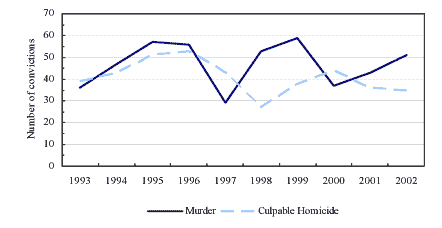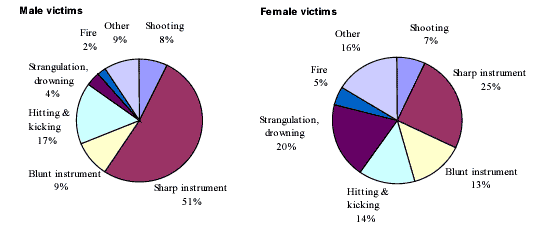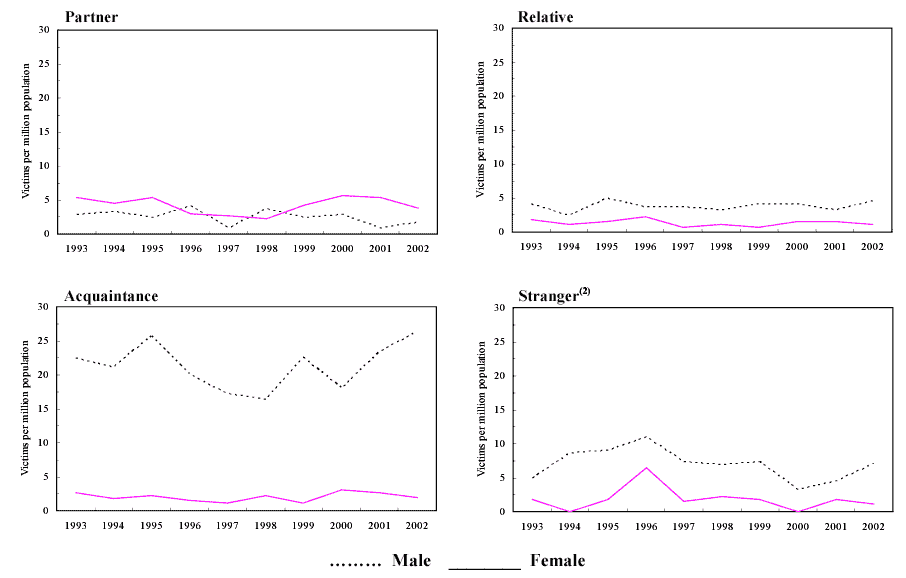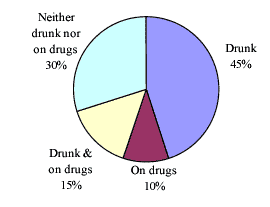Homicide in Scotland, 2002
Statistics on homicide in Scotland, 2002
This document is part of a collection
Statistical Bulletin Criminal Justice Series CrJ/2003/9 HOMICIDE IN SCOTLAND, 2002
5. Persons Accused of Homicide (Tables 7, 8 & 9)
Age and sex ( Table 7)
5.1 In total there were 186 accused persons in the homicide cases recorded in 2002, 35 more than in 2001 and the highest figure recorded since 1995. As in previous years, most (89 per cent) of these were male.
5.2 In 2002, the total number of individuals accused of homicide equated to 40 per million population. Within age/sex groups, this rate was highest for males aged 16 to 20 (253 per million population) followed by males aged 21 to 29 (156 per million population).
Results of Proceedings ( Tables 8 and 9)
5.3 Of the 186 persons accused in the homicide cases recorded in 2002, 51 (27 per cent) have had a charge of murder proved to date (i.e. as at 30 October 2003). A further 35 (19 per cent) accused persons have had a charge of culpable homicide proved, of whom 27 were given a sentence of 4 years or more imprisonment. Nineteen accused persons (10 per cent) have so far been acquitted of homicide charges. The remaining 81 (44 per cent) of accused persons either had some other outcome, e.g. had no proceedings taken against them, or their case was still pending.
5.4 Over the last 10 years, 55 per cent (877) of accused persons in homicide cases had a charge proved against them and 16 per cent were acquitted. The remaining 29 per cent had some other outcome or their case is still classified as pending. Of those persons with a charge proved against them, 83 per cent were sent to prison or a young offenders institution, including 58 per cent who were given a life sentence. Thirty-six accused persons (4 per cent of the total) were given hospital orders and/or were judged to be insane.
Chart 9: Numbers convicted of murder and culpable homicide, 1993-2002

Appeals
5.5 There were 216 appeals against convictions for murder and 101 against convictions for culpable homicide between 1993 and 2002. For appeals against convictions for murder, the majority (88 per cent) were dismissed or abandoned. The remaining 12 per cent resulted in the conviction being quashed, the conviction being changed from murder to culpable homicide or the ordering of a retrial. Over a quarter (28 per cent) of appeals against culpable homicide convictions resulted in a reduced sentence, with a further 7 per cent being successful in having the conviction quashed, a retrial ordered or another appeal sustained, e.g. where the prosecution had appealed against the leniency of the original sentence. For the remaining two-thirds of cases, the appeal was either dismissed or abandoned.
Table C: Appeals against convictions for murder (1) and culpable homicide, by outcome, 1993-2002
Crime of which convicted before appeal |
||
Murder |
Culpable homicide |
|
Total number (=100%) |
216 |
101 |
Percentage resulting in: |
||
Conviction quashed |
4 |
1 |
Conviction reduced |
4 |
- |
Sentence reduced |
- |
28 |
Retrial |
3 |
4 |
Other appeal sustained |
- |
2 |
Appeal dismissed |
38 |
39 |
Appeal abandoned (2) |
50 |
27 |
1. Excludes appeals by persons convicted of murder appealing against the effective start date of their sentence.
2. Includes, from September 1995 onwards, appeals refused at sift stage.
6. Circumstances of Homicides (Tables 10, 11, 12, 13 & 14)
Method
6.1 The most common method of killing in 2002 was a sharp instrument, accounting for 68 victims (54 per cent of the total). This was the highest figure recorded in the last 10 years, and was almost entirely responsible for the overall increase in homicides between 2001 and 2002. Males aged 16 to 49 comprised three-quarters (76 per cent) of these victims. In the ten year period 1993-2002, a sharp instrument was the most common method of killing of both males and females (45 per cent of the total), though as can be seen from chart 10 it was relatively more common for males than for females. Among the other methods of killing, the next most common for males was hitting and kicking (17 per cent of victims), while for females it was strangulation/drowning (20 per cent of victims). Death by shooting is relatively rare - there were only 3 such victims in 2002, all male.
Chart 10: Method of killing by sex, 1993-2002

Relationship of main accused to victim
6.2 For 78 per cent of the 127 homicide victims in 2002, the main accused was known to them, either as an acquaintance (57 per cent), a partner (11 per cent) or a relative (11 per cent) ( Table 11). A sixth (17 per cent) of victims were killed by a stranger. For the remaining 4 per cent of victims, the relationship to the main accused was unknown or no accused person had yet been identified.
6.3 Chart 11 illustrates the trends over the last 10 years in homicide rates for male and female victims by their relationship to the main accused. The highest rate for males has consistently been killing by an acquaintance. For females the highest rate was generally killing by a partner. The most striking aspect of these trends is that fluctuations in the rate for males killed by acquaintances largely drive fluctuations in the overall homicide rate. The rates for all other types of homicides remained relatively stable, and low, throughout the 1993-2002 period.
Chart 11: Homicide rates by sex of victim and relationship of main accused to victim(1 ), 1993-2002

1. Currently (as at 30 October 2003) recorded as homicide victims.
2. Includes the 17 victims (5 male and 12 female) of the Dunblane incident in 1996.
6.4 Over the last 10 years, a total of 93 children under the age of 16 were victims of homicide. Of these, 52 per cent were killed by one of their parents ( Table 12). Excluding the victims of the Dunblane incident, this proportion was 63 per cent. For the 27 victims aged under a year old, the main accused (where known) was either a parent or other relative.
6.5 For homicides recorded in the last ten years, 42 per cent of the female victims aged between 16 and 69 were killed by their partner and a further 1 per cent were killed by another relative. Only 11 per cent of female adults in this age group were killed by someone unknown to them. For male victims aged 16 to 69, only 7 per cent were killed by their partner, and a further 4 per cent by a relative. The majority (58 per cent) of male victims aged 16 to 69 in the past 10 years were killed by an acquaintance, 18 per cent by a stranger.
6.6 Of the 49 older people (aged 70 and over) who were victims of homicide in the 10 years from 1993 to 2002, 25 were male and 24 female. Forty-one per cent of these (20 victims) were killed by a stranger, a higher rate than among younger adults. A total of 9 older people were killed by their son or daughter, 6 by a partner and 13 by someone else known to them.
Motivation
6.7 Eighteen victims (14 per cent of all victims) were reported to have been killed in a drug-related homicide case in 2002. Fifteen of these victims were male and 3 female.
6.8 None of the homicides recorded in 2002 were reported to have had a racial or homophobic motivation.
6.9 The most common reasons recorded for homicide in 2002 were rage/fury or fight/quarrel, with 56 per cent of victims killed in such circumstances. This was slightly higher than in the previous decade when this proportion averaged 44 per cent.
6.10 The most common set of circumstances in which females become victims of homicide are in a dwelling, in a rage/fight with a partner ( Table 14). Location is less of a factor for male victims, whose killing more typically is a result of a rage/fight with an acquaintance. Only 25 per cent of all female victims in the period 1993-2002 were killed out with a dwelling, compared with 51 per cent of males.
Drink/drug status ( Tables 15 and 16)
6.11 The drink/drug status was reported for 127 (68 per cent) of accused persons in homicide cases recorded in 2002. Of these, 45 per cent were drunk, 10 per cent on drugs and 15 per cent were both drunk and on drugs. Where known, the proportion of accused who were drunk was highest for those in the age group 16-20 (75 per cent) and 50 and over (80 per cent). The proportion of accused under the influence of drugs was highest for persons aged 21-29 (43 per cent) ( Chart 12).
6.12 In most cases (84 per cent) where the main accused was drunk and/or on drugs, the victim was also known to have been drunk and/or on drugs. Where the main motive was a fight or quarrel, 77 per cent of main accused for whom the drink/drug status was known were drunk and/or under the influence of drugs. In most of these cases the victim was also drunk and/or on drugs at the time the homicide took place.
6.13 In 7 of the 24 cases (29 per cent) where the main accused was known to be neither drunk nor on drugs, the victim was reported to be drunk or on drugs.
Chart 12: Drink/drug status of accused (where known), 2002

7. Time for cases to be dealt with by the criminal justice system ( Table 17)
7.1 In the majority of homicide cases an accused person is charged within 1 month of the date the homicide is recorded. For those persons charged with a homicide recorded in 2002, 89 per cent were charged within a month of the date the homicide was recorded. For over a third (38 per cent) of persons charged with homicides recorded in 2002, the period from date of charging to the completion of criminal proceedings was less than 6 months. This continued a downward trend in the proportion of persons where a final outcome was reached within 6 months, from 80 per cent in 1997.
8. International comparisons of homicide rates ( Table 18)
8.1 Care must be taken in making international comparisons of crime statistics due to different counting rules and definitions, e.g. some countries include attempted murders in their homicide figures. However, it is of interest to observe how Scotland's homicide rate compares with those in other countries. The rates shown in Table 18 are the average annual rates for the period 1999 to 2001, as these are the latest published data available for most countries. Scotland's average yearly homicide rate between 1999 and 2001 was 22 victims per million population. This was higher than the rate in England and Wales (16), lower than in Northern Ireland (27) and comparable with the rates of Poland (21) and Hungary (23).
8.2 Glasgow had a homicide rate of 59 victims per million population between 1999 and 2001, similar to the rate in Belfast (56) and a little over double the rate in London (26). The homicide rates in the other Scottish cities were relatively low compared with the other European cities listed in Table 18.
There is a problem
Thanks for your feedback